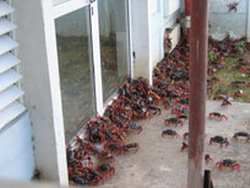Red Crabs Invade Guanahacabibes
- Submitted by: admin
- Local
- Travel and Tourism
- Destinations
- Environment
- Pinar del Río
- Society
- Science and Technology
- 05 / 01 / 2009

Abel Sosa Prieto, one of the park specialists, says that with the arrival of spring and the first rains, the red crabs (Gecarcinus ruricola) take over the road that is closed of to visitors to the park to make way for the crabs’ lovemaking spectacular.
The park is a giant natural reserve with a wide array of flora and fauna including the miniature hummingbird, 172 species of birds from 42 families, ancient iguanas and 4 species of marine turtles that lay eggs along the beaches during the month of June.
The red crabs feed on detritus and so they are considered nature’s cleaners. They like to make their sea voyage between 11 and 12 each day. Each crab deposits thousands of eggs in the water.
People from nearby towns such as La Bajada used to frequently fed on these animals and even commercialize them, until researchers from the Park held informative talks warning of the dangers of eating these crabs. Frequent ingestion can lead to the accumulation of tungsten causing a reduction in the production of sperm in men, and also can cause diarrhea and kidney necrosis. .
The Cienaga de Zapata is another area in Cuba that has similar red crabs invasions.
Source: Juventud Rebelde
Comments